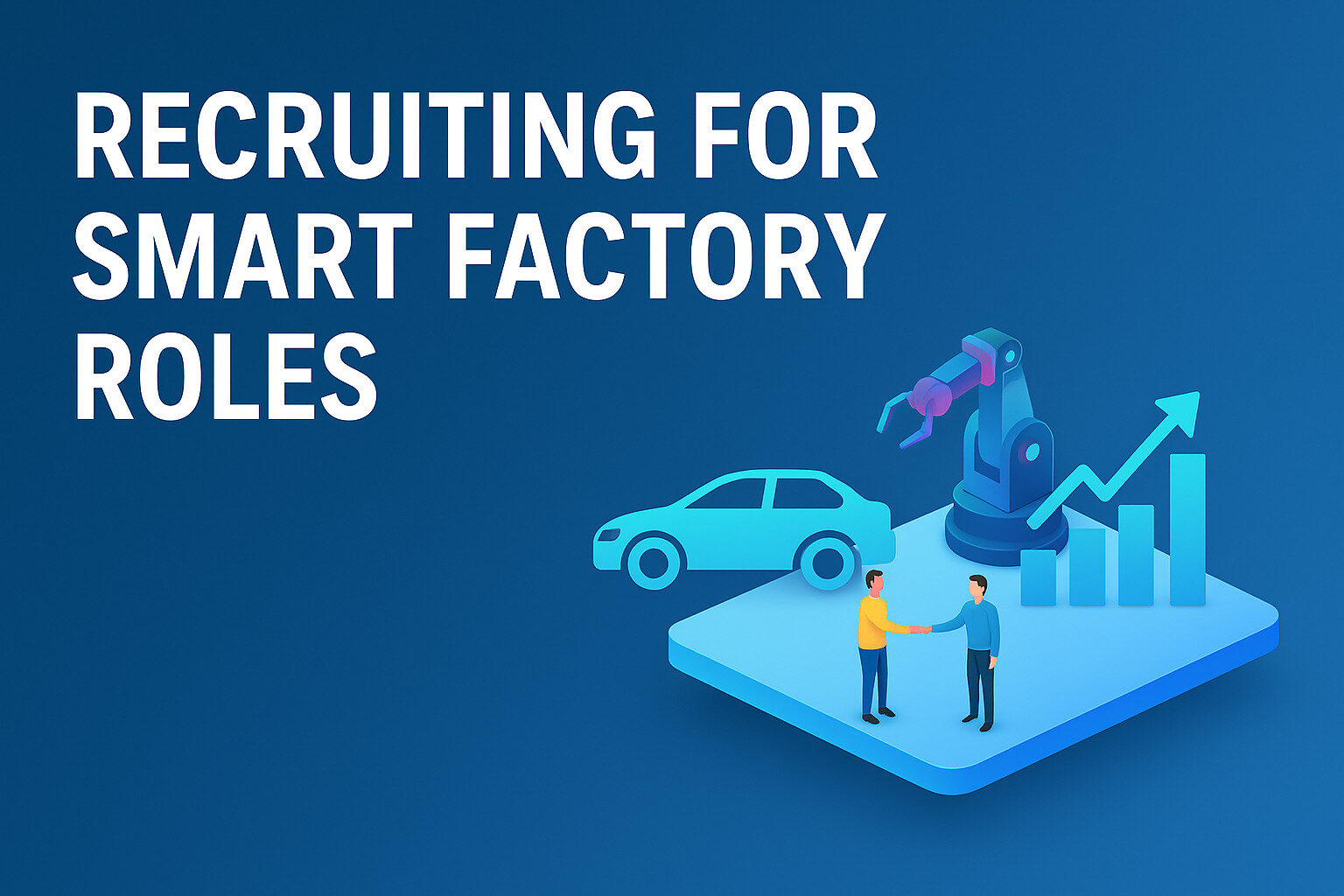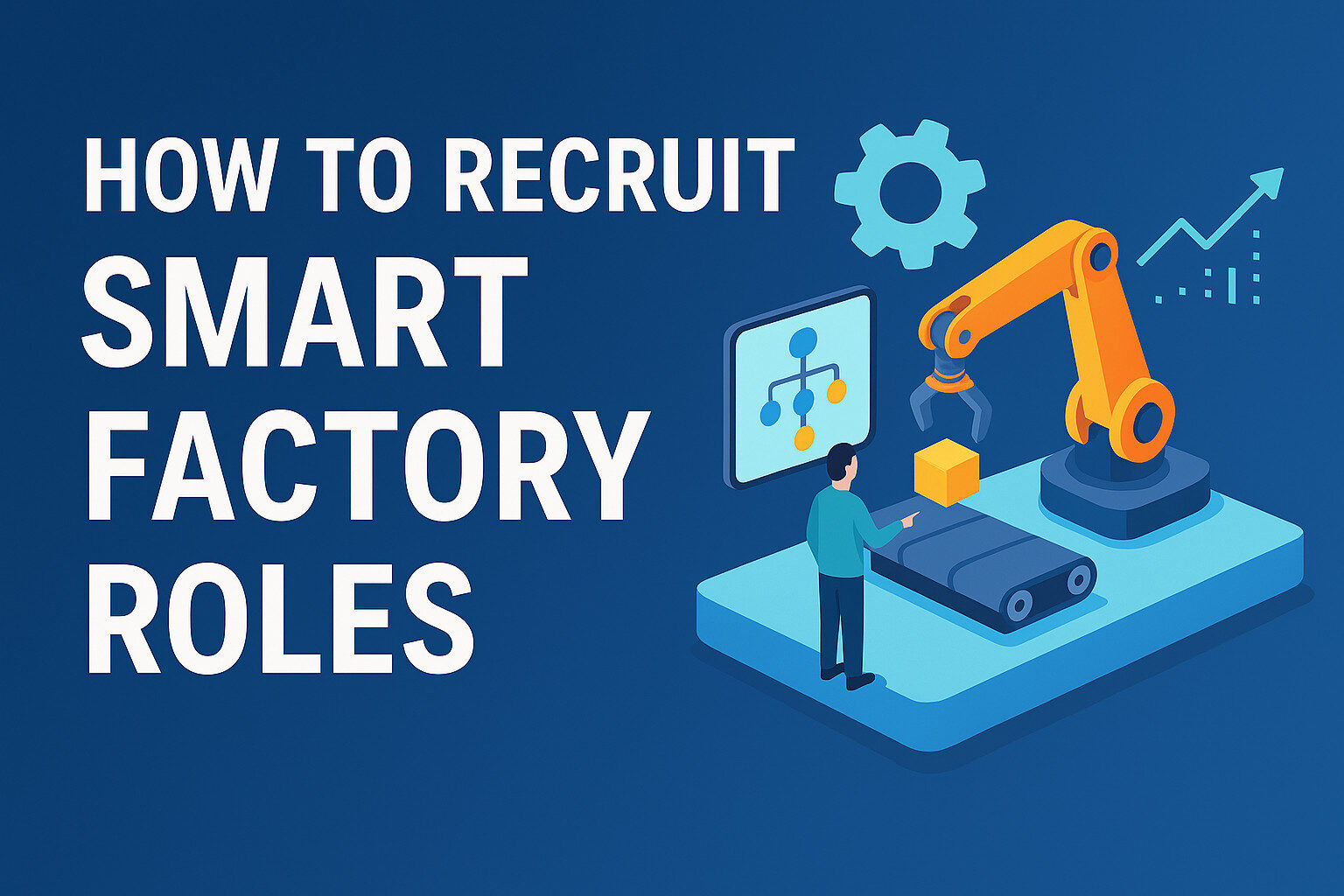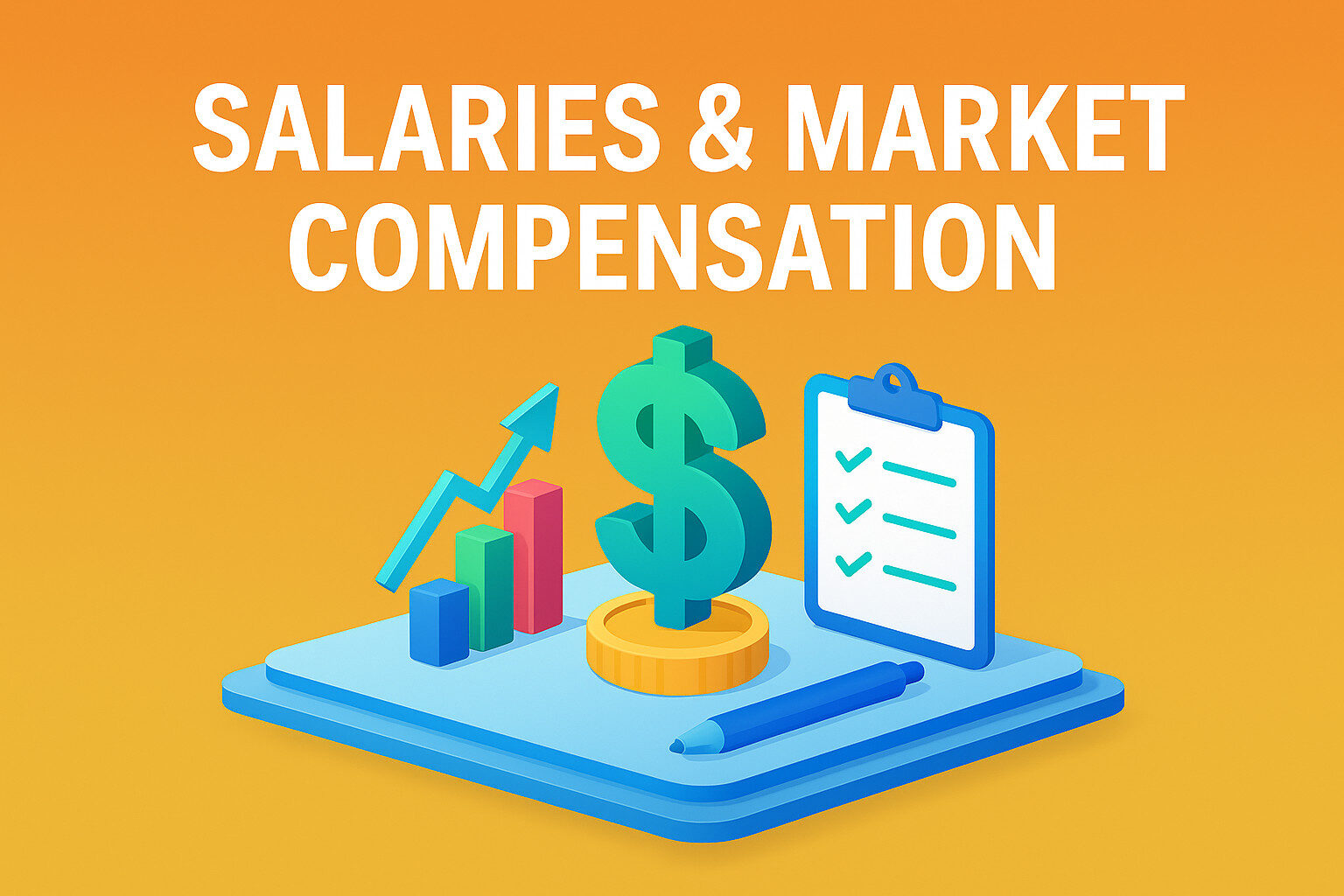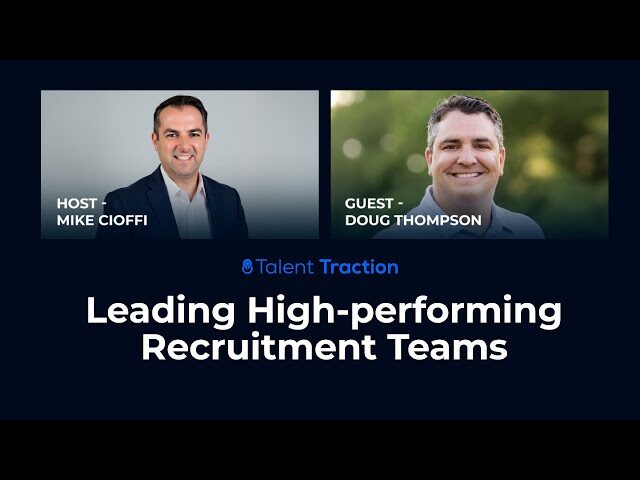In today’s manufacturing world, recruiting smart factory roles isn’t optional it’s mission critical. As factories evolve from manual, repetitive assembly lines into digitized, automated, and sensor-driven operations, the roles you need to hire change drastically. If you stay stuck posting generic “manufacturing operator” jobs, you’ll struggle to find people who can actually run or improve your next generation of plants.
This blog walks you through:
- What “smart factory” really means (and the roles it demands)
- The rising trends and data behind automation in U.S. manufacturing
- Challenges in hiring for smart factory roles
- Best practices, strategies, and frameworks to recruit effectively
- How to assess candidates with the right blend of technical + soft skills
- Metrics to measure success
- How TalentTraction’s white-glove recruiting can help you win
By the time you finish reading, you’ll know exactly what to look for, how to attract top talent, and how to avoid costly mis-hires in the era of smart manufacturing.

1. What is a “Smart Factory” and Why It Changes Recruiting
A “smart factory” blends automation, IoT (Internet of Things), data analytics, AI, robotics, and connectivity into manufacturing operations. The aim is real-time insights, self-optimizing processes, predictive maintenance, and adaptive production.
Unlike traditional assembly lines, smart factories demand roles that can:
- Interpret data from sensors and machines
- Program, maintain, and troubleshoot automation systems
- Integrate software and hardware interfaces
- Manage AI / predictive models for quality, maintenance, yield
- Bridge between IT/OT (Information Technology / Operational Technology) domains
Because of this shift, traditional operator roles are evolving. You’re no longer just hiring for manual dexterity you need hybrid skillsets: mechanical, electrical, software, analytical, and systems thinking.
2. The Data & Trends Driving Automation & Smart Factories
To understand why you must recruit smart factory roles now, here are some key data points and market dynamics:
- The global factory automation market was valued at ~$215 billion in 2023 and is projected to grow at a CAGR of ~9.8% between 2023–2030.
- In the U.S., industrial automation roles (automation engineers, PLC programmers, controls, system integrators) currently number around 290,000 positions, with salary ranges between $72,000 and $114,000, depending on seniority and region.
- Hiring difficulty is high: only about 9 candidates per open role in certain automation roles. Job openings often stay open ~74 days on average before filling.
- Historically, automation displacement has been significant: ~1.7 million manufacturing jobs in the U.S. have been lost to automation since 2000.
- The U.S. Bureau of Labor Statistics suggests that nearly 47% of U.S. jobs could be at high risk of automation over the coming decades, particularly those with repetitive or routine tasks.
- In industrial automation hiring trends, roles such as Controls Systems Engineers, PLC Programmers, Field Technicians, and System Integrators are among the most in demand.
These data points underline a critical gap: demand for smart factory talent is accelerating, while supply is constrained.
3. Key Smart Factory Roles You Must Recruit For
Here are the core roles you should expect to hire (or upskill internally) in a smart factory environment:
Role | Core Responsibilities | Skills / Qualifications | Seniority / Variants |
Automation Engineer / Controls Engineer | Design, program, integrate automation systems (PLC, SCADA, HMI) | PLC (Rockwell, Siemens, etc.), ladder logic, control theory, networking, PID, safety systems | Junior → Lead / Specialist |
Systems Integrator | Integrate disparate machines, sensors, software, communications | API, MES/ERP integration, protocol translation, IoT connectivity | Typically mid to senior |
IoT / Data Engineer | Process machine-generated data, create pipelines to feed analytics | Data pipelines, time-series DBs, MQTT, edge computing, APIs | Mid-level & above |
Predictive Maintenance / Reliability Engineer | Use sensor data & analytics to predict and prevent failures | Vibration analysis, fault detection algorithms, condition monitoring | Experience in industrial settings |
Robotics / Mechatronics Technician | Maintain, troubleshoot, repair robot systems and subsystems | Mechanical, electrical, servo control, kinematics, safety | Hands-on, often hybrid skillsets |
Automation Project Manager | Oversee rollout of automation projects, ensure delivery | Project management, integration, budget, cross-functional coordination | Senior / leadership track |
Because these roles combine domains (mechanical, electrical, software), pure specialists are rare; hybrid professionals are gold.
4. Challenges in Hiring for Smart Factory Roles
Transitioning from assembly-line roles to smart roles brings unique challenges. Here are some you will run into:
a) Talent Scarcity & Skill Mismatch
Many candidates lack the full hybrid skillset. You may find someone great at PLCs but weak on IoT, or vice versa.
b) Competition Across Industries
Smart factory talent is in demand not just in traditional manufacturing industries like aerospace, energy, logistics, and semiconductor also compete for the same candidates.
c) Geographical Limitations
Manufacturing plants in remote or non-metropolitan areas may struggle to attract talent unless compensation or relocation support is strong.
d) Cultural Resistance
Existing employees may feel threatened by automation. Resistance to change, fear of job displacement, or lack of trust in new tech can slow adoption and hinder recruiting.
e) Evaluating Soft Skills & Learning Agility
Technical skills can be taught, but a candidate’s ability to learn, adapt, collaborate with software & operations teams, and navigate cross-disciplinary systems is harder to assess.
f) Long Hiring Cycles & High Risk of Mismatch
Roles often take months to fill. Without careful screening, you risk hiring someone who doesn’t mesh with your plant architecture or standards, leading to performance or retention issues.

5. How to Recruit Smart Factory Roles: Best Practices & Strategy
Here’s a playbook (step-by-step) for recruiting effectively:
1. Define Role Profiles Precisely
Don’t write vague “automation engineer needed” ads. Break the role into technical modules (PLC, networking, data, robotics), list preferred tool sets, and highlight what the first 6–12 months look like.
2. Use Multi-Channel Sourcing
- Niche platforms & communities: Automation forums, LinkedIn groups, control systems associations
- Partnerships with educational institutions: Universities, technical schools with automation or mechatronics programs
- Referrals & internal upskilling: Promote high-potential operators into hybrid roles
- Talent mapping / competitor poaching: Identify who is working in similar roles and engage them proactively
3. Executive-Led Outreach
Having senior leaders or engineering leads reach out to candidates (e.g. LinkedIn InMail) improves response rates and credibility. A message from your automation director or VP of operations adds weight.
4. Technical Assessments & Realistic Tasks
Instead of generic tests, use simulations or real-world tasks (PLC logic, diagnosing sensor faults, integrating a module) to assess fit. Score for problem-solving, debugging under pressure, and cross-system thinking.
5. Focus on Learning Potential & Cross-Domain Experience
Because full specialists are rare, prioritize candidates who show aptitude across domains someone who knows mechanical control but wants to learn networking or data pipelines.
6. Sell the Opportunity, Not Just the Job
Smart factory candidates are looking for growth and challenges. Emphasize:
- Opportunities to lead automation projects
- Exposure to cutting-edge tech (IoT, AI, Industry 4.0)
- Career path into digital operations, engineering, leadership
- Great learning environment & engineering culture
- Pay + benefits structured to reflect their specialized value
7. Onboarding & Mentorship
Smart factory roles often require cross-team collaboration (IT, operations, maintenance). Start the candidate with a structured onboarding that pairs them with mentors, gives exposure to systems, and gradually moves them from smaller support tasks to strategic projects.
8. Retention Strategies & Career Development
Once onboarded, don’t let them stagnate. Provide continuous training (PLC upgrades, data engineering, cybersecurity), project leadership opportunities, and clear progression paths.
6. Evaluating & Scoring Smart Factory Candidates
Here’s a sample evaluation framework (weighted scoring) you can adapt:
Dimension | Weight | What to Test / Look For |
Technical Competence | 30% | PLC programming, networking, control logic, robotics |
System Integration Ability | 20% | Understanding how pieces sensors, software, machines work together |
Problem-Solving / Debugging | 20% | Diagnosing faults, reading logs, root cause analysis |
Learning Agility / Adaptability | 10% | Comfort picking up new tech, self-directed learning |
Communication & Collaboration | 10% | Ability to work with ops, IT, maintenance, leadership |
Cultural Fit & Vision | 10% | Alignment with innovation, safety, quality values |
Use tests, structured interview questions, case simulation, team-interview feedback, and reference checks to validate.

7. Industry Benchmarks: Salaries & Market Compensation
To help you calibrate your offers, here are compensation benchmarks & trends from recent data:
- Automation / industrial automation roles in the U.S. typically range $72,000–$114,000 depending on experience, region, and responsibility.
- Because of shortage, companies often offer premium incentives, signing bonuses, relocation packages, or profit-sharing to attract top smart factory candidates.
- As automation becomes more central, salary differential between traditional operator roles and smart roles is widening expect to pay 1.5x to 2x for specialized talent.
- Benefits, training budgets, and project ownership opportunities also become critical differentiators beyond base pay.
8. Metrics & KPIs for Smart Factory Recruiting Success
Track these to continuously improve your recruiting function:
- Time to Fill (smart roles vs traditional roles)
- Quality of Hire (performance, uptime impact, defect reduction)
- Offer Acceptance Rate
- Attrition / Retention after 1 year
- Pipeline Depth (number of screened candidates per role)
- Source Effectiveness (which channels yield best hires)
- Candidate Satisfaction / Experience
Measure these quarterly and share with leadership it’s not just HR metrics, it’s business impact.
9. Common Mistakes & How to Avoid Them
- Overemphasizing “automated tools” experience while ignoring fundamentals (control logic, safety, mechanical basics)
- Relying on off-the-shelf generic job templates instead of role-specific specs
- Ignoring culture and communication fit smart factory roles often bridge silos
- Neglecting candidate experience in long sales cycles
- Underestimating training and onboarding investments
- Failing to project clear career paths into digital leadership
10. How Talent Traction’s White-Glove Approach Supports Smart Factory Recruitment
At Talent Traction, we specialize in recruiting industrial, manufacturing, and automation talent and we do it with white-glove precision. Here’s how we help you execute the above strategy:
- Market mapping & talent intelligence: We identify active & passive candidates working in automation, controls, IoT, digital manufacturing across the U.S.
- Executive outreach support: We help craft messaging (InMails, emails, videos) led or co-signed by your engineering/ops leadership to boost credibility.
- Technical screening & assessment design: We build tailored assessments, realistic case simulations, and scoring systems to filter for your specs.
- Candidate experience management: We own the communication, follow-ups, and top-tier engagement so you present a polished brand.
- Benchmark & compensation advisory: We guide offers, signing bonuses, and total compensation packages to match market and candidate expectations.
- Retention planning and onboarding support: We help you craft onboarding plans, mentorship programs, and career development paths so hires succeed long-term.
If you want us to help you recruit for your first smart factory role—whether a controls engineer, IoT specialist, or integration lead—reach out and we’ll tailor a white-glove plan for you.
11. Conclusion & Next Steps
Transitioning from assembly line to automation requires more than machines it demands the right talent, culture, and recruiting discipline. The gap between demand and qualified supply is real, but bridgeable with intentional strategy.
Next steps you can take immediately:
- Audit your pipeline: what smart factory roles do you need in 6–12 months?
- Write detailed, modular role specs breaking down technical domains.
- Begin proactive sourcing and outreach well before roles become urgent.
- Partner with engineering or automation leads for co-outreach.
- Build assessment tools and structured interview frameworks to rank candidates objectively.
- Track metrics for continuous improvement.
If you’re ready to elevate your recruiting, especially for smart factory roles, Talent Traction’s white-glove service is designed to get you from “no candidates” to “ideal hire” quickly and reliably. Let’s talk.




